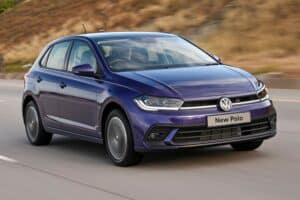Replacement for the Sandero will initially be made in Brazil powered by a new turbocharged engine capable of running either on petrol or ethanol.

Announced as becoming a reality last year, Renault, after a series of teaser images this month, has officially taken the wraps off the new Kardian as its replacement for the Sandero in South America.
Change in focus
Originally reported as being a coupe-styled crossover aimed at the Volkswagen Nivus, known as the Taigo in South Africa, the Kardian represents the opposite as Renault has instead opted for a conventional crossover design along the lines of the new Dacia Sandero Stepway.
ALSO READ: Incoming Renault Kardian’s interior revealed in new teaser
Developed specifically for South America, the Kardian takes-up station above the Kwid as not only the successor to the Sandero, but also gap filler above the former not occupied by the Kiger marketed mainly in right-hand-drive developing nations.
Dimensions
The first model outside Europe to debut’s Renault’s latest styling language, the Kardian rides on the same CMF-B platform as the Sandero, Clio and Captur, but measures 4 119 mm long, 2 025 mm wide and 1 595 mm tall while riding on a wheelbase stretching 2 604 mm.
With a ground clearance of 209 mm, the Kardian’s dimensions represent an 88 mm increase in overall length over the Sandero, with the claimed width being wider by 23 mm and height taller by 96 mm.

Its wheelbase being similar to the Sandero though, the Kardian counters with boot space; 410-litres with the rear seats up versus the Sandero’s 328-litres.
Mounted on 17-inch diamond-cut alloy wheels, and in-line with claims uncovered two weeks ago, the relations with the Sandero stops at the platform sharing as the exterior and interior are all model specific with very little being carried over.
Inside and out
The first model launched under Renault’s International Game Plan 2027 involving markets not part of its European plans, the Kardian boasts not only a Renault specific grille with the firm’s latest 3D corporate logo, but also a sharp front splitter, a dual headlight design, black wheel arch cladding, a satin silver faux skidplate and expansive lower air intake.
Down the side, similarities with the previous generation Sandero are visible, but stops at the rounded C-pillar that follows into a smaller rear window and a down a more concave tailgate to the bumper, which also receives an imitation skidplate.
As with the thin strip upper LED headlights, the taillights also feature LED diodes, encased in Renault’s now trademark C-shaped clusters that have been blacked-out as a means of “reinforcing the SUV character and modernity of Kardian”.

Equipped with roof rails as standard, a total of five colours have been selected; Glacier White, Cassiopea Grey, Pearl Black, Star Grey and Orange Energy contrasted from the off by a black roof.
Previewed by the most recent image, the interior shares little with not only the Sandero, but also the Clio and Captur.
Besides the steering wheel, the dashboard is new and the central hangdown section furnished with physical switchgear for the climate control panel Renault has angled towards the driver.

In a first for South America, the Kardian gets a digital instrument cluster, measuring seven-inches, as standard, along with a freestanding 10.25-inch touchscreen infotainment system incorporating Apple CarPlay and Android Auto, and the Multi-Sense drive mode selector with three settings; Eco, Sport and MySense.
Additionally, the slim-line centre console houses a pair of cupholders, the electronic handbrake and a Golf GTI-style toggle switch for the six-speed EDC transmission as no manual will be offered.
Notable safety and driver assistance systems comprise six airbags as standard regardless of trim level, Blind Spot Monitoring, Adaptive Cruise Control, Front Collision Warning, Autonomous Emergency Braking, Hill Start Assist, Electronic Stability Control and a surround-view camera system.
Standard turbo boost
Backing-up the transmission, and as originally speculated, the Kardian will derive motivation from a single engine; a made-in Brazil 1.0-litre three-cylinder turbo capable of running either on petrol or ethanol.
Supposedly not related to the similar displacement units powering the Kiger and Clio, the mill produces 92kW/220Nm, which goes via the mentioned transmission to the front wheels only. No performance or fuel consumption figures were disclosed.
No-no for now
On-sale from March next year produced first at the Curitiba Plant in Brazil and then later at the Casablanca facility in Morocco, pricing for the Kardian wasn’t disclosed, with the same applying to whether it will become a world model made in both left-and-right-hand-drive.
As such, and for the time being, it won’t be coming to South Africa as a possible gap filler between the most expensive Kiger, priced at R349 999, and the cheapest Captur stickered at R479 999.
NOW READ: New crossover flavoured Renault Kardian emerges in first teaser






